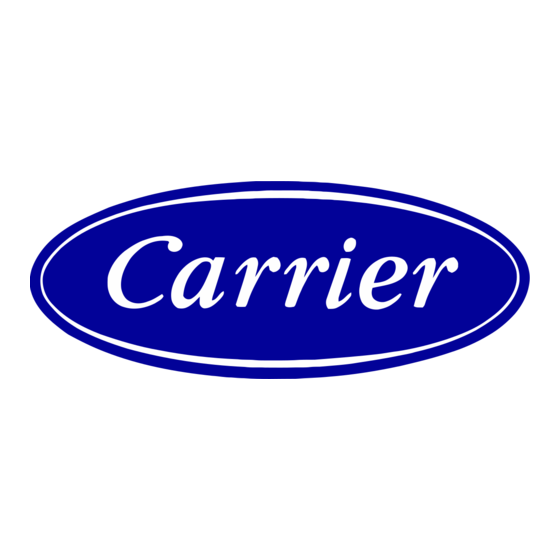

Carrier 50EZ-A Installation Instructions Manual
Comfort 13 seer single-packaged heat pump system with puron (r-410a) single and three phase 2-5 nominal tons
Hide thumbs
Also See for 50EZ-A:
- Product data (30 pages) ,
- Owner's information manual (6 pages) ,
- Owner's information manual (6 pages)
Advertisement
Quick Links
Download this manual
See also:
Product Data
Installation Instructions
to the expe_
NOTE:
Read
the entire
instruction
manual
before
starting
the
installation.
NOTE:
Installer:
Make
sure the Owner's
Manual
and Service
Instructions
are left with the unit after installation.
TABLE
OF CONTENTS
PAGE
SAFETY
CONSIDERATIONS
.......................
1-2
INTRODUCTION
...................................
2
RECEIVING
AND INSTALLATION
..................
2-9
Check Equipment
..................................
2
Identify
Unit
....................................
2
Inspect
Shipment
.................................
2
Provide
Unit Support
...............................
2
Roof Curb
......................................
2
Slab Mount
.....................................
2
Provide
Clearances
.................................
2
Rig and Place Unit
.................................
3
Inspection
......................................
3
Rigging/Lifting
of Unit
............................
7
Select and Install Ductwork
...........................
7
Converting
Horizontal
Discharge
Units to Downflow
(Vertical)
Discharge
Units
..........................
8
Provide
for Condensate
Disposal
......................
9
Install Electrical
Connections
.........................
9
High-Voltage
Connections
.........................
9
Special
Procedures
for 208-V
Operation
..............
10
Control
Voltage Connections
.......................
10
Standard
Connections
............................
10
Transformer
Protection
...........................
10
Accessory
Electric heaters Installation
................
10
PRE-START-UP
...................................
18
START-UP
.....................................
18-24
Checking
Cooling
& Heating
Control
Operation
........
18
Check for Refrigerant
Leaks
.........................
18
Start-Up
Adjustments
.............................
18
50EZ-A
Sequence
of Operation
....................
19
Checking
& Adjusting
Refrigerant
Charge
............
19
Indoor Airflow
& Airflow
Adjustments
..............
19
Continuous
Fan Operation
........................
20
Defrost
Control
...................................
24
Quiet Shift
.....................................
24
Defrost
.......................................
24
MAINTENANCE
..................................
24-
Air Filter
........................................
24
Indoor
Blower
and Motor
...........................
24
Outdoor
Coil, Indoor
Coil, & Condensate
Drain Pan
......
25
Outdoor
Fan
.....................................
25
Electrical
Controls
and Wiring
.......................
27
Refrigerant
Circuit
.................................
27
Indoor Airflow
...................................
28
Metering
Devices-
TXV & Piston
....................
28
Pressure
Switches
.................................
28
Loss of Charge
Switch
.............................
28
High Pressure
Switch
..............................
28
Copeland
Scroll compressor
(Puron
Refrigerant)
.........
28
A09034
Fig. 1 - Unit 50EZ-A
Refrigerant
System
................................
28
Refrigerant
....................................
28
Compressor
Oil .................................
28
Servicing
Systems
on Roofs with Synthetic
Materials
....
28
Liquid Line Filter Drier ...........................
29
Puron®
(R-410A)
Refrigerant
Charging
.............
29
System
Information
................................
29
Loss of Charge Switch
............................
29
Check Defrost Thermostat
.........................
29
TROUBLESHOOTING
..............................
29
START-UP
CHECKLIST
............................
29
SAFETY
CONSIDERATIONS
Installation
and servicing
of this equipment
can be hazardous
due
to
mechanical
and
electrical
components.
Only
trained
and
qualified
personnel
should
install, repair, or service this equipment.
Untrained
personnel
can perform
basic maintenance
functions
such
as cleaning
and replacing
air filters.
All other operations
must be
performed
by trained
service
personnel.
When
working
on this
equipment,
observe
precautions
in the literature,
on tags,
and on
labels
attached
to
or shipped
with
the
unit
and
other
safety
precautions
that may apply.
Follow
all safety codes.
Wear safety
glasses,
protective
clothing,
and work
gloves.
Use quenching
cloth
for brazing
operations.
Have
a fire
extinguisher
available.
Read
these
instructions
thoroughly
and
follow
all warnings
or cautions
included
in
literature
and
attached
to the unit. Consult
local building
codes, the
current
editions
of the National
Electrical
Code (NEC)
NFPA
70.
In Canada
refer to the current
editions
of the Canadian
electrical
Code CSA C22.1.
Recognize
safety information.
This is the safety-alert
symbol
Z_.
When you see this symbol
on the unit and in instructions
or manu-
als, be alert to the potential
for personal
iniury.
Understand
these
signal
words:
DANGER,
WARNING,
and
CAUTION.
These
words
are used with
the safety-alert
symbol.
DANGER
identifies
the most serious
hazards
which will result in severe personal
iniury
Advertisement











Need help?
Do you have a question about the 50EZ-A and is the answer not in the manual?
Questions and answers